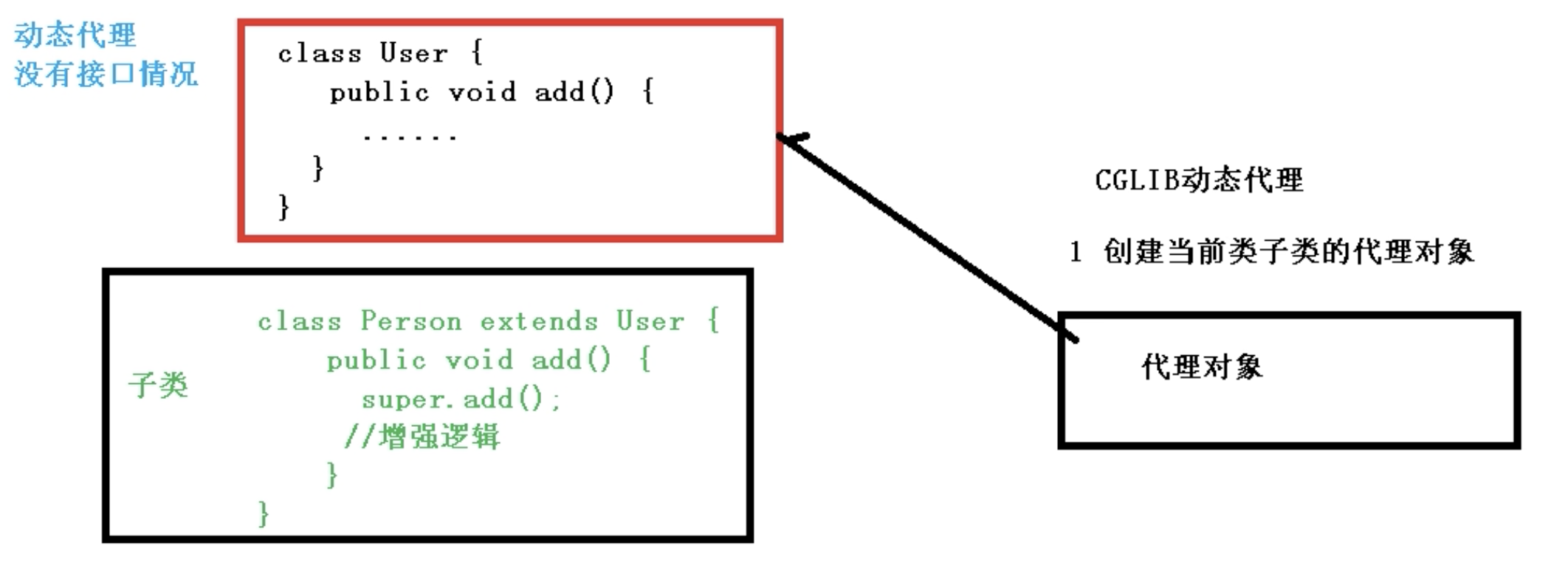https://cos-1301609895.cos.ap-nanjing.myqcloud.com/aop4.png
一、AOP底层使用动态代理 1、两种动态代理 a、有接口 需使用JDK的动态代理,创建接口实现类的代理对象,增强类的方法,如下图:
b、没有接口 使用CGLIB动态代理,继承父类重写父类方法,实现代理,如下图:
二、AOP(JDK动态代理) 1、使用JDK动态代理,使用Proxy类里的方法创建代理对象
Class Proxy
使用下面这个方法创建代理类的实例:
newProxyInstance方法三个参数的含义:
ClassLoader loader:类加载器 类<?>[] interfaces:增强方法所在的类,这个类所实现的接口 InvocationHandler h:实现这个接口InvocationHandler,创建代理对象,写增强的方法
2、使用JDK动态代理来写代码 a、创建接口,定义方法 1 2 3 4 public interface UserDao public int add (int a, int b) public String update (String id) }
b、创建接口实现类,实现方法 1 2 3 4 5 6 7 8 9 10 public class UserDaoImpl implements UserDao @Override public int add (int a, int b) return a + b; } @Override public String update (String id) return id; } }
c、使用Proxy类创建接口代理对象 匿名内部类方式:
1 2 3 4 5 6 7 8 9 10 11 12 public class JDKProxy public static void main (String[] args) Class[] interfaces = {UserDao.class}; Proxy.newProxyInstance(JDKProxy.class.getClassLoader(), interfaces, new InvocationHandler() { @Override public Object invoke (Object proxy, Method method, Object[] args) throws Throwable return null ; } }); } }
实现接口的方式:
1 2 3 4 5 6 7 8 9 10 11 12 13 14 15 16 17 18 19 20 21 22 23 24 25 26 27 28 29 30 31 32 public class JDKProxy public static void main (String[] args) Class[] interfaces = {UserDao.class}; UserDao userDao = new UserDaoImpl(); UserDao dao = (UserDao) Proxy.newProxyInstance(JDKProxy.class.getClassLoader(), interfaces, new UserDaoProxy(userDao)); int result = dao.add(1 , 2 ); System.out.println(result); } } class UserDaoProxy implements InvocationHandler private Object object; public UserDaoProxy (Object obj) this .object = obj; } @Override public Object invoke (Object proxy, Method method, Object[] args) throws Throwable System.out.println("方法之前执行......" + method.getName() + ":传递的参数是" + Arrays.toString(args)); Object res = method.invoke(object, args); System.out.println("方法之前执行......" + object); return res; } }
三、AOP(术语) 1、连接点 类里面哪些方法可以被增强,这些方法称为连接点
2、切入点 实际真正被增强的方法,这些方法称为切入点
3、通知(增强) 实际增强的逻辑部分,即增加的代码逻辑部分,通知有以下几种:
4、切面 指的是一个动作,指把通知应用到切入点的过程
四、AOP操作(准备) Spring框架一般都是基于AspectJ实现AOP操作的
1、什么是AspectJ AspectJ不是Spring的组成部分,它是一个独立的AOP框架,一般将Spring和AspectJ一起使用,从而进行AOP操作
2、基于AspectJ实现AOP操作 a、基于xml配置文件方式实现 b、基于注解方式实现(使用) 3、在项目工程中引入相关AOP依赖 需要引入以下相关依赖:
4、切入点表达式 a、切入点表达式的作用 知道对哪个类里面的那个方法进行增强
b、语法结构 execution( [权限修饰符] [返回类型] [类全路径] [方法名称] ( [参数列表] ) )
对一个类里的某一个方法进行增强
对一个类里的所有的方法进行增强
对包里的所有类,类里面的所有方法进行增强
1 2 3 4 5 6 7 8 9 10 11 12 13 14 ``` ### 五、AOP操作(AspectJ注解) #### 1、创建类,在类中定义方法 ```java public class User public void add () System.out.println("add()......" ); } }
2、创建增强类(编写增强逻辑) 在增强类里面创建方法,让不同的方法代表不同的通知
1 2 3 4 5 6 7 public class UserProxy public void before () System.out.println("before()......" ); } }
3、进行通知的配置 a、在Spring配置文件中,开启注解扫描 1 2 3 4 5 6 7 8 9 10 11 12 <?xml version="1.0" encoding="UTF-8"?> <beans xmlns ="http://www.springframework.org/schema/beans" xmlns:xsi ="http://www.w3.org/2001/XMLSchema-instance" xmlns:context ="http://www.springframework.org/schema/context" xmlns:aop ="http://www.springframework.org/schema/aop" xsi:schemaLocation ="http://www.springframework.org/schema/beans http://www.springframework.org/schema/beans/spring-beans.xsd http://www.springframework.org/schema/context http://www.springframework.org/schema/context/spring-context-3.0.xsd http://www.springframework.org/schema/aop http://www.springframework.org/schema/aop/spring-aop-3.0.xsd" > <context:component-scan base-package ="com.atguigu.spring5.aopanno" > </context:component-scan > </beans >
b、使用注解创建User和UserProxy对象 给 User和 UserProxy加上 @Component
c、在增强的类上面添加注解@Aspect @Aspect代表生成的对象
d、在Spring配置文件中开启生成代理对象 1 2 <aop:aspectj-autoproxy > </aop:aspectj-autoproxy >
4、配置不同类型的通知 在增强类里面,在作为通知方法最上面添加通知类型注解,使用切入点表达式配置
如下在 UserProxy类中加上 @Before注解:
1 2 @Before(value = "execution(* com.atguigu.spring5.aopanno.User.add())")
接下来我们看看所有的通知类型:
1 2 3 4 5 6 7 8 9 10 11 12 13 14 15 16 17 18 19 20 21 22 23 24 25 26 27 28 29 30 31 32 33 34 @Component @Aspect public class UserProxy @Before(value = "execution(* com.atguigu.spring5.aopanno.User.add())") public void before () System.out.println("before()......" ); } @After(value = "execution(* com.atguigu.spring5.aopanno.User.add())") public void after () System.out.println("after()......" ); } @AfterReturning(value = "execution(* com.atguigu.spring5.aopanno.User.add())") public void afterReturning () System.out.println("afterReturning()......" ); } @AfterThrowing(value = "execution(* com.atguigu.spring5.aopanno.User.add())") public void afterThrowing () System.out.println("afterThrowing()......" ); } @Around(value = "execution(* com.atguigu.spring5.aopanno.User.add())") public void around (ProceedingJoinPoint proceedingJoinPoint) throws Throwable System.out.println("环绕之前......" ); proceedingJoinPoint.proceed(); System.out.println("环绕之后......" ); } }
注意点:
5、相同切入点的抽取 如上述代码的 "execution(* com.atguigu.spring5.aopanno.User.add())"部分,具体如何做请看代码:
1 2 3 4 5 6 7 8 9 10 @Pointcut(value = "execution(* com.atguigu.spring5.aopanno.User.add())") public void pointdemo () @Before(value = "pointdemo()") public void before () System.out.println("before()......" ); }
6、增强类的优先级 当有多个增强类对同一个方法进行增强时,我们可以设置增强类的优先级。在增强类上面添加注解 @Order(数字类型值),数字类型值越小代表优先级越高,如下 PersonProxy的优先级为1:
1 2 3 4 5 6 @Component @Aspect @Order(1) public class PersonProxy ······ }
7、完全注解开发 创建配置类,不再需要配置文件,只需创建如下配置类:
1 2 3 4 5 @Configuration @ComponentScan(basePackages = {"com.atguigu"}) @EnableAspectJAutoProxy(proxyTargetClass = true) public class ConfigAop }
六、AOP操作(AspectJ配置文件) 未完待续……



